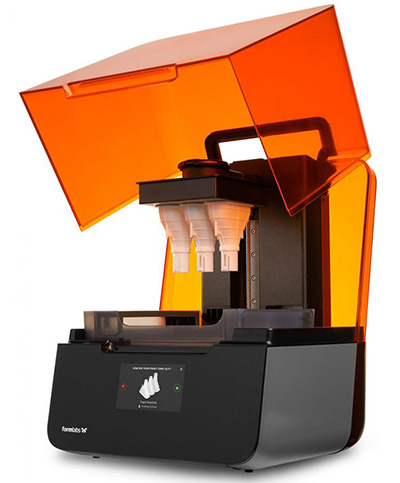FormLabs 3 SLA Printer
Overview
The FormLabs Form3 SLA printer is a high-precision printer that makes parts in a variety of different plastics with properties like high toughness, high flexibility, high durability, ESD resistance, and high thermal resistance. Compared to traditional FFF printing, this process tends to be more expensive, take longer, and have a smaller max part size. Additionally, there are also some specific design requirements when printing parts on this machine.
This machine is typically used if:
- The part needs to be of a very high surface quality
- Specific material properties are needed
- When a combination of high surface quality and specific material properties is needed
- If the part is small and has a high level of detail
Design Considerations
Orientation
Print orientation effects almost all aspects of the print, including part surface quality, part strength, tolerances of certain part features, print time, support material used (thus cost), and ultimately the changes of a successful print. Proper orientation is key to part success. If a specific orientation is needed for functional reasons, this needs to be noted when submitting a job, otherwise the orientation that maximizes part success chances and minimizes cost will be chosen.
Some orientation considerations are:
- Virtually all parts and part geometries will require some form of support in this process which will leave witness marks on the part. Orient parts to put these on non-critical surfaces
- Certain geometries like hollow cavities will create “cups” that will cup resin and not let it properly drain, which can cause issues
- Adding Z-height dramatically increases print time
- After printing, the part needs to be UV cured. This involves heating the part up and exposing it to UV light. This can lead to part warping if the part has a lot of thin walls and/or if it is not supported properly
Part Design
3D printing is a manufacturing process like any other. Like other processes, it has its own limitations and design requirements; not all parts can or should be printed.
Some design considerations are:
- Avoid large horizontal overhangs
- Certain geometries like hollow cavities will create “cups” that will cup resin and not let it properly drain, which can cause issues
- This process can print complex internal cavities; however, these cavities need to be able to drain to get excess resin out. Failure to do this will result in failed internal geometry.
Printer Settings/Options:
- Layer Height Options: 25 – 200 microns (0.001” to 0.008”)
- Infill Percentage Options: Solid
Technical Specs:
- XY Print Size: 145mm (5.70”) by 145mm (5.70”)
- Z Print height: 185mm (7.28”)
- Layer heights: 25 – 300 microns (.001” to .012”)
- XY Resolution: 25 microns (.001”)
*specs are from the manufacturer webpage and don’t necessarily mean options listed here will be available through the lab
Available Material Options
Draft, Grey, Clear, Tough 1500, High Temperature
Visit formlabs.com/materials/ for a comprehensive list of material possibilities.

